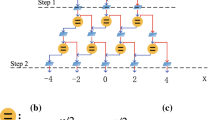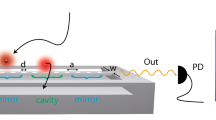Abstract
Kitaev model has both Abelian and non-Abelian anyonic excitations. It can act as a starting point for topological quantum computation. However, this model Hamiltonian is difficult to implement in natural condensed matter systems. Here we propose a quantum simulation scheme by constructing the Kitaev model Hamiltonian in a lattice of coupled cavities with embedded Λ-type three-level atoms. In this scheme, several parameters are tunable, for example, via external laser fields. Importantly, our scheme is based on currently existing technologies and it provides a feasible way of realizing the Kitaev model to explore topological excitations.
Similar content being viewed by others
References
Qi X L, Zhang S C. The quantum spin Hall effect and topological insulator. Phys Tod, 2010, 63: 33–38
Hasan M Z, Kane C K. Colloquium: Topological insulator. Rev Mod Phys, 2010, 82: 3045–3067
Nayak C, Simon S H, Stern A, et al. Non-Abelian anyons and topological quantum computation. Rev Mod Phys, 2008, 80: 1083–1159
Kitaev A. Fault-tolerant quantum computation by anyons. Ann Phys, 2003, 303: 2–30
Levin M A, Wen X G. String-net condensation: A physical mechanism for topological phases. Phys Rev B, 2005, 71: 045110
Einarsson T. Fractional statistics on a torus. Phys Rev Lett, 1990, 64: 1995–1998
Das Sarma S, Freedman M, Nayak C. Topologically protected qubits from a possible non-Abelian fractional quantum Hall state. Phys Rev Lett, 2005, 94: 166802
Kitaev A. Anyons in an exactly solved model and beyond. Ann Phys, 2006, 321: 2–111
Feng X Y, Zhang G M, Xiang T. Topological characterization of quantum phase transitions in a spin-1/2 model. Phys Rev Lett, 2007, 98: 087204
Kells G, Slingerland J K, Vala J. Description of Kitaev’s honeycomb model with toric-code stabilizers. Phys Rev B, 2009, 80: 125415
Wootton J R, Lahtinen V, Wang Z, et al. Non-Abelian statistics from an Abelian model. Phys Rev A, 2008, 78: 161102
Buluta I, Nori F. Quantum simulators. Science, 2009, 326: 108–111
You J Q, Shi X F, Hu X, et al. Quantum emulation of a spin system with topologically protected ground state using superconducting quantum circuits. Phys Rev B, 2010, 81: 014505
Duan LM, Demler E, Lukin MD. Controlling spin exchange interactions of ultracold atoms in optical lattices. Phys Rev Lett, 2003, 91: 090402
Zhang C, Scarole V W, Tewari S, et al. Anyonic braiding in optical lattices. Proc Natl Acad Sci USA, 2007, 104: 18415–18420
Micheli A, Brennen G K, Zoller P. A toolbox for lattice-spin models with polar molecules. Nat Phys, 2006, 2: 341–347
Jackeli G, Khaliullin G. Mott insulators in the strong spin-orbit coupling limit: From Heisenberg to a quantum compass and Kitaev models. Phys Rev Lett, 2009, 102: 017205
Angelakis D G, Santos MF, Bose S. Photon-blockade-induced Mott transitions and XY spin models in coupled cavity arrays. Phys Rev A, 2007, 76: 031805
Hartmann M J, Brandáo F G S L, Plenio M B. Effective spin system in coupled microcavities. Phys Rev Lett, 2007, 99: 160501
Cho J, Angelakis D G, Bose S. Simulation of high-spin Heisenberg models in coupled cavities. Phys Rev A, 2008, 78: 062338
Chen Z X, Zhou Z W, Zhou X, et al. Quantum simulation of Heisenberg spin chains with next-nearest-neighbor interactions in coupled cavities. Phys Rev A, 2010, 81: 022303
Cho J, Angelakis D G, Bose S. Fractional quantum Hall state in coupled cavities. Phys Rev Lett, 2008, 101: 246809
Hartmann M J, Brandáo F G S L, Plenio M B. Strongly interacting polaritons in coupled arrays of cavities. Nat Phys, 2006, 2: 849–855
Greentree A D, Tahan C, Cole J G, et al. Quantum phase transitions of light. Nat Phys, 2006, 2: 856–861
Song B S, Noda S, Asano T, et al. Ultra-high-Q photonics double-heterostructure nanocavity. Nat Mater, 2005, 4: 207–210
Aoki T, Dayan B, Wilcut E, et al. Observation of strong coupling between one atom and a monolithic microresonator. Nature, 2006, 443: 671–674
Hennessy K, Badolato A, Winger M, et al. Quantum nature of a strongly coupled single quantum dot-cavity system. Nature, 2007, 445: 896–899
James D F V, Jerke J. Effective Hamiltonian theory and its applications in quantum information. Can J Phys, 2007, 625-629
Spillane S M, Kippenberg T J, Vahala K J, et al. Ultrahigh-Q toroidal microresonators for cavity quantum electrodynamics. Phys Rev A, 2005, 71: 013817
Vučković J, Lončar M, Mabuchi H, et al. D Design of photonic crystal microcavities for cavity QED. Phys Rev E, 2001, 65: 016608
Hood C J, Lynn T W, Doherty A C, et al. The atom-cavity microscope: Single atoms bound in orbit by single photons. Science, 2000, 287: 1447–1453
Author information
Authors and Affiliations
Corresponding author
Rights and permissions
About this article
Cite this article
Xiang, Z., Yu, T., Zhang, W. et al. Implementing a topological quantum model using a cavity lattice. Sci. China Phys. Mech. Astron. 55, 1549–1556 (2012). https://doi.org/10.1007/s11433-012-4864-9
Received:
Accepted:
Published:
Issue Date:
DOI: https://doi.org/10.1007/s11433-012-4864-9




